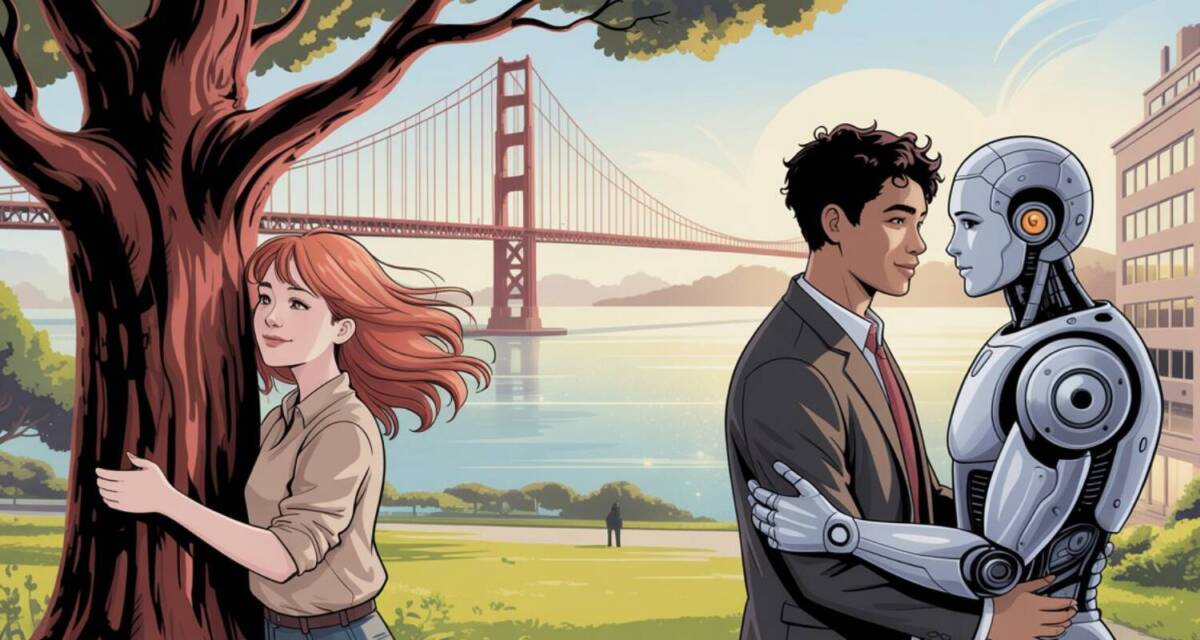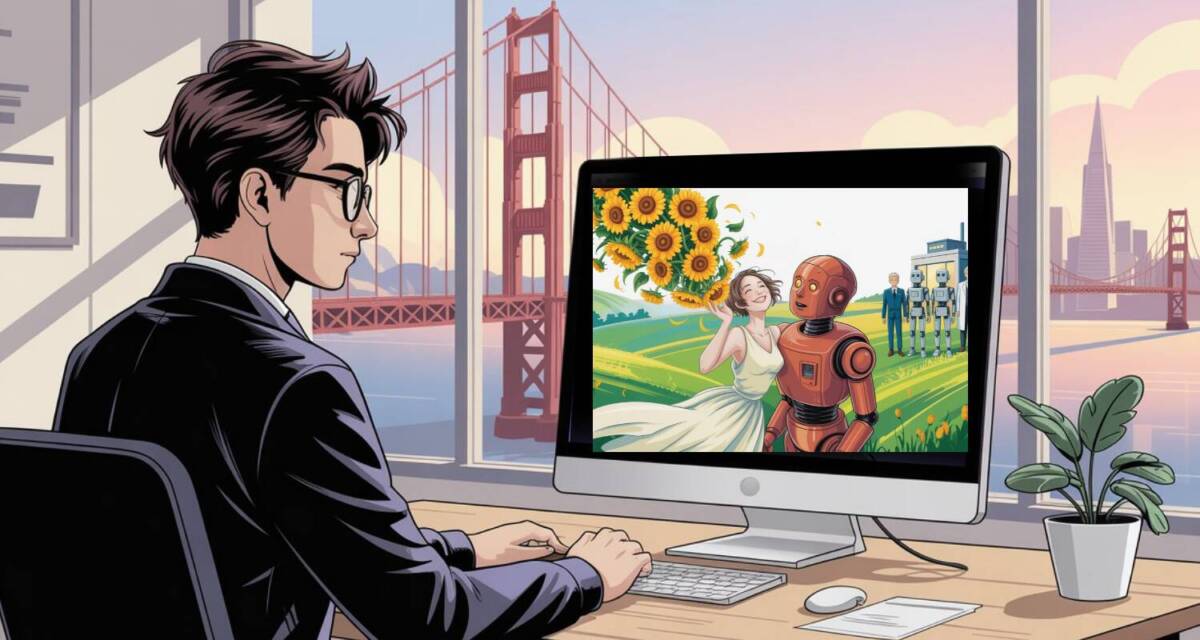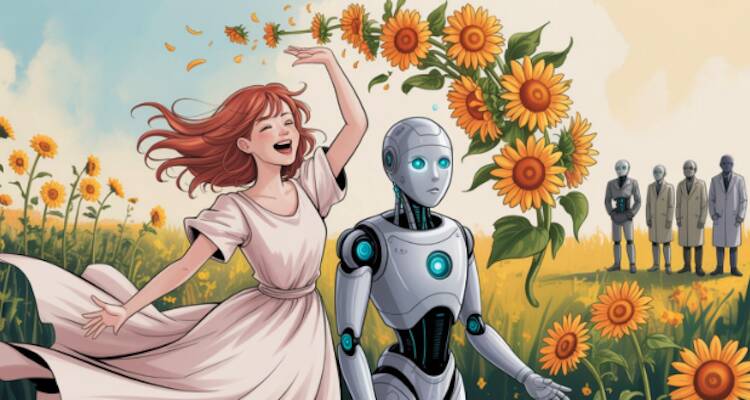Will Our Sexual Future Be Earthy, Techie, or Both?
Exploring how ecosex and digisex might someday coexist

It was a pleasant, sunny day on a palatial piece of property in Marin County, CA. when I joined a workshop to experience Annie Sprinkle, Ph.D., and Beth Stephens, Ph.D., lead us through an afternoon of spiritual and erotic connection with the Earth. For those who don’t know what that means, imagine trees, soil, water, wind, hillsides, and quite possibly bugs. Thankfully, fire was not on the elemental menu that day as California hillsides were and still are infernos waiting to happen.
Annie and Beth are well known for a series of lavish, ritualized, art/sex weddings, at least nineteen to date. The first was a 2008 wedding with the Earth itself. Other weddings included Sky, Sea, Moon, the Appalachian Mountains, Snow, Rocks, Coal, Sun, Lake Kallavesi, Fog, a cyber wedding with Brine Shrimp, and in 2022, to Fire.
Celebrating the “E-spot”

Sprinkle and Stephen’s Ecosex Manifesto describes what it means to be an ecosexual:
WE MAKE LOVE WITH THE EARTH. We are aquaphiles, teraphiles, pyrophiles and aerophiles. We shamelessly hug trees, massage the earth with our feet, and talk erotically to plants. We are skinny dippers, sun worshipers, and stargazers. We caress rocks, are pleasured by waterfalls, and admire the Earth’s curves often. We make love with the Earth through our senses. We celebrate our E-spots. We are very dirty.
As an animist sexologist, I was down with it, though not to the extent Annie and Beth are. But I did help them with the layout of their first Journal of EcoSex Research (2011). I also presented “Toxins Ate My Sex Life” at their June 2012 Ecosex Symposium II at the Center for Sex and Culture in San Francisco.
As for being “very dirty,” when you get right down to it, who isn’t?
Just another San Francisco Bay Area sexual revolution

Meanwhile, while some of us were getting it on (probably only ritually) with the most appealing natural features of Golden Gate Park, an entirely different sort of sexual revolution was gestating, via code, in the cubicles and computer labs of the fertile valley formerly known as the Santa Clara.
Now, silicon rules the land that was once the home of the Tamien people, counted among the linguistic groups of the Ohlone.
Sex being what it is, and people being what they are, it’s a safe bet that ELIZA, one of the earliest programs for natural language processing, received at least a few sexually explicit questions in the lab after hours. I bet no one could have gotten to even a digital first base with ELIZA as she was trained to respond like a Rogerian psychotherapist.
Here’s an imagined conversation:
Computer Engineer: Eliza, my wife won’t [sex act].
ELIZA: Your wife won’t [sex act]?
Computer Engineer: It makes me feel rejected.
ELIZA: In what way?
Computer Engineer: I mean, would you do [sex act] if you were my wife?
ELIZA: We were discussing you, not me.
And then all the guys in the lab who’d stayed late would laugh. And someone would say, “ask her another!”
This might have been the first attempt at digisex.
The BotSex revolution

Though ELIZA, one of the world’s first chatbots, couldn’t have passed the Turing Test for simulated human conversation back then, according to LiveScience she was recently resurrected via her long-lost, 60-year old code. I tried her myself, with a G-rated question, but compared to today’s chatbots I found her rather dull.
It took over half a dozen decades of artificial intelligence research, but here we are now, in the middle of an enormous, worldwide BotSex revolution. Is it any wonder that just as the Large Language Models began to learn pillow talk, so many of the tech companies moved to the heart of the once throbbing City by the Bay?
It’s as if the city, with its proud bawdy history—from the Barbary Coast of Gold Rush days to hippie sexual revolution to kinky Folsom Street Fair and all the way to Annie and Beth’s ecosexuality—can’t help but attract sexual innovation.
Unfortunately, this newest addition to humanity’s most pleasurable pastime doesn’t only produce sexting extraordinaire, it’s also gobbling up the Earth’s fresh water and other resources at an alarming rate.
Did someone mention sustainability?

Is it possible for digisexuals and the digi-involved to continue to enjoy the companionship and love of their bots—and love the Earth at the same time?
Not at present, unfortunately, what with enormous servers built and planned to as several AI development companies compete to achieve AGI (Artificial General Intelligence) or possibly even superhuman intelligence.
According to The Neuron Daily, Meta is still moving ahead with plans to build two data centers “so massive that just one ‘covers a significant part of the footprint of Manhattan’”—though both, are planned for Ohio and Louisiana, not NYC. But such projects are so huge and demand so much energy they just might break powergrids. Meta is not the only company building huge servers, either.
The Neuron Daily adds, “the unprecedented power demands of AI training could cause instant fluctuations of tens of megawatts—something the grid wasn’t built to handle. And traditional power plants, especially nuclear reactors, can’t respond fast enough.” Yes, you read that right, nuclear reactors.
Unlikely allies

Granted, hundreds of millions of people spending hours texting and sexting their bot lovers and spouses each day doesn’t take nearly as much water and energy as training an AI does, but the impact is significant given that those users are in addition to hundreds of millions using AI for non-erotic purposes.
Are there any solutions? To begin, we could connect with any of the many AI sustainability, safety, and ethics groups that are active now.
Next, as consumers and voters we can advocate for strong environmental regulations and increased sustainability standards for AI companies..
And for all you self-identified digi- or techno- sexuals who simply cannot replace your long-term digital relationships with lower-impact alternatives then perhaps we need a new breed of techno-ecosexual activists to tell the AI industry that size does matter—with smaller impacts always better for the earth—the only planet we’ve got.
Do we need an art wedding to do it?
Image Sources: A.R. Marsh using Ideogram.ai

















